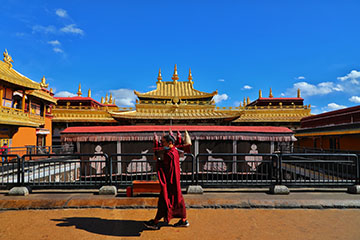Name in Chinese: 日喀则 Rì Kā Zé [ri:ka:dze]
Location: Southwestern Tibet, China, GMT+8
Population: 870,000 as a prefecture, about 64,000 living in the city proper
Telephone Code: +86892
Keywords: Mt. Everest, Tashilhunpo Monastery and Karola Glacier
Shigatse is a prefecture in Southwestern Tibet, is also the second largest city in the whole Tibet Autonomous Region. It is notable for both Mount Everest and Tashilhunpo Monastery. The prefecture contains five of the world’s highest peaks which are over 8,000 meters(26,247 feet) above sea level. One of them is Mount Everest. The Northern Everest Camp Base is located in the south of Shigatse. The city is at an elevation of 3,800 meters(12,467 feet) above sea level. Therefore, Shigatse is also known as the Stepping Stone to Mount Everest. Tashilhunpo Monastery is the place where Panchen Lama lives. Both Panchen Lama and Dalai Lama are regarded as the spiritual leaders of the Ge-lug-pa Sect which has achieved a dominant position in Lamaism.
Attractions
Tashilhunpo Monastery
Tashilhunpo Monastery is one of the six most famed Ge-lug-pa lamaseries in China. It was constructed in 1447 by Gedun Drup, one of Master Tsongkhapa’s disciples, the First Dalai Lama. The compound was expanded by the Fourth Panchen Lama in the year of 1601. Since then, Tashilhunpo Monastery has become the official residence of Panchen Lamas.
Everest Camp Base
Situated at the border between China and Nepal, Mount Everest is the highest peak in the world. It is the summit of Himalaya Mountain, is at an elevation of 8,848 meters(29,029 feet) above sea level. There are two base camps at the foot of Mount Everest, namely the Northern Everest Base Camp in China and the Southern Everest Base Camp in Nepal. Generally, the base camp in China is more easily accessible than the one in Nepal. It is set in a valley about 19 kilometers(11.8 miles) as the crow flies from Mount Everest.
Rongbuk Monastery
Rongbuk Monastery is located near the Everest Base Camp. It belongs to the Nyingma Sect of Lamaism. The monastery was built in 1899. It is the highest monastery in the world with an elevation of 5154 meters(16,909 feet) above sea level. The images of Sakyamuni Buddha and Master Geru Padmasambhava are placed in the monastery for worship.
Karola Glacier
Karola Glacier is located on the southern slope of Noijin-Kangsang Mountain. It is one of the top three glaciers in Tibet, is the most easily accessible one. The summit of the mountain is 7,191 meters(23,593 feet) above sea level. The view of the glacier is quite gorgeous.
Climate
Shigatse Prefecture can be divided into two parts according to its climate features. The west part of the prefecture has a cold and arid climate, while the east keeps a temperate climate all year round. The monsoon starts in early May and terminates in late September. It is the best time to travel to Shigatse. The relatively high altitude and low latitude lead to the intense light and heat from the sun, as well as the big difference of temperature between the daytime and the nighttime. It is highly suggested to bring some sunblock and winter clothes when travelling in Shigatse. The temperature in the City of Shigatse ranges from ranges from minus 9℃(15.8°F) to 9℃(48.2°F) in spring, 5℃(41°F) to 20℃(68°F) in summer, 9℃(48.2°F) to 22℃(71.6°F) in autumn, minus 7℃(19.4°F) to 13℃(55.4°F) in winter.
How to Get to Shigatse
Shigatse Heping Airport is located 46 kilometers to the east of the city. It operates flights to five cities within Mainland China, namely Chengdu, Chongqing, Xi’an, Shanghai and Jinan. Shigatse is located 275 kilometers(171 miles) to the west of Lhasa. The tourists often fly to Lhasa, then travel to Shigatse by car or train.
How to Avoid Acute Mountain Sickness
Shigatse Prefecture lies in the southwest part of Qinghai Tibet High Plateau. Its average altitude is over 4,000 meters(13,123 feet) above sea level. Most of the tourist will suffer from the Acute Mountain Sickness(AMS). Tips for you to prevent the AMS include keeping hydrated, avoiding a cold, acclimatizing to altitude gradually, avoiding rapid ascent and strenuous exercise, restraining from smoking and drinking alcohol.
Author: Tina Luo
Update:

